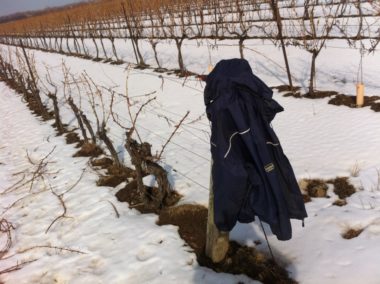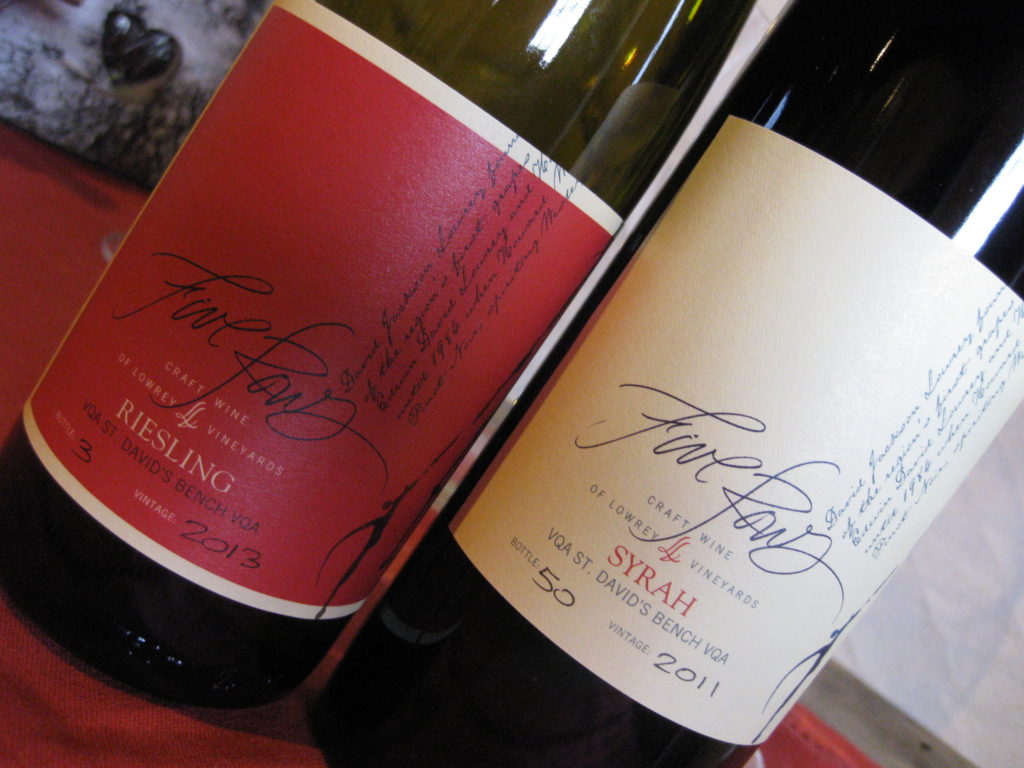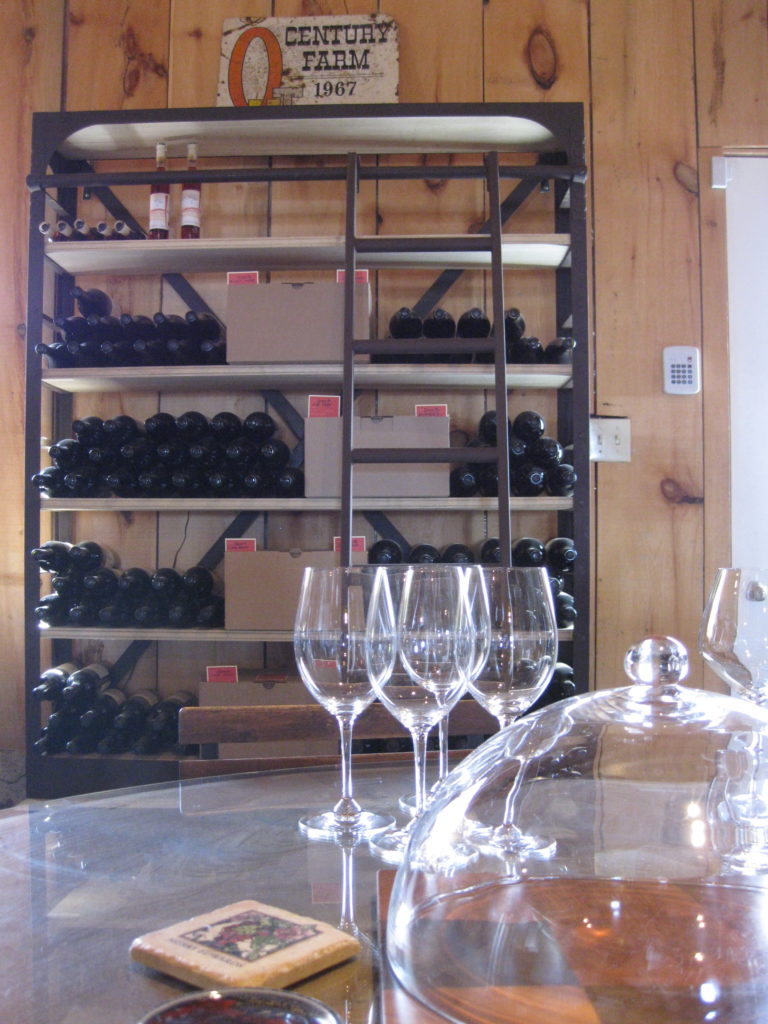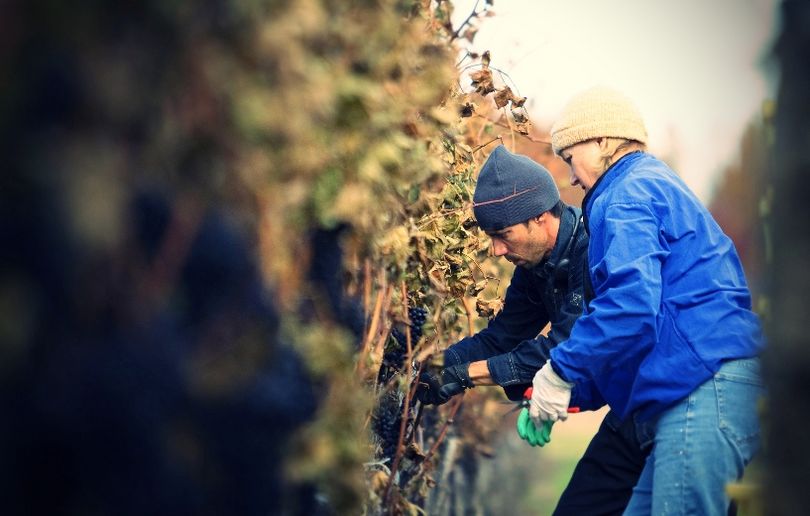Overwhelming Response
I’m overwhelmed at the response we’ve received to our new wines and the number of keen visitors we’ve entertained over the last couple of weeks! It is all we can do to write and apply labels fast enough to keep up.
I’ve become accustomed to putting off my vineyard work on weekends in May to stick around the barn and help the girls with tastings. I must admit that I secretly enjoy this, as it allows me to overhear all the interesting and thoughtful reviews of my wines. There is always a gut-wrenching fear belying my calm facade that these wines won’t live up to their predecessors. You would think that after nine vintages of wrenching guts I might have learned to trust my palate by now, but it always takes a few satisfied customers to reassure me.
That is all part of what makes this time of year is so exciting, from the inbox full of pre-orders to the smiling faces of return visitors parading through the barn door. The fact that people would think enough of our wines to pre-order them on spec, without even trying them first, is the ultimate in trust. I treasure this trust as much as any award or five star review we’ve ever received. The “pre-order” is my gold medal.
With that trust comes the pressure not to disappoint. This challenge drives what I do in the vineyard every summer. In the back of my mind is the knowledge that this vine I’m currently thinning will produce fruit to make a wine that someone may already have dibs on for next year. On one hand it’s a very reassuring thought, but it also means there isn’t much room for error!
As the first buds of 2014 start to reveal themselves one precious leaf at a time, I confidently venture out to the vineyard and strive to earn more trust.
New Wines
On the eve of the New Release here at Five Rows there is palpable anticipation is in the air. The barn is full, brimming with fresh wines ready to introduce themselves to some palates. Taking a mental snapshot of these tall stacks I recall the sheer amount of work that went into each one of these wines from the first moment of bud emergence until now. There is contentment in this reflection.
I leisurely wax the cork tops while Wilma pens and applies the new labels. Next weekend we will officially open for the year and debut all of the recently bottled 2013 whites and 2011 reds. Experience tells me that there will be nothing “leisurely” about the next couple of weekends, as all of our friends stop in to pick up their orders. It’s a whirlwind of visits and tasting, but we wouldn’t have it any other way!
The First Official Jacket Hanging of 2014
It’s official. March 10, 2014 marked the first outdoor workday of the year that I was compelled to take off my jacket and hang it over an endpost in a symbolic act of optimism. I don’t know that I’ve ever enjoyed a day of pruning (and fetching) this much. I guess it takes a long, cold winter to make a 7 degree March afternoon feel so heavenly.
Lucy will miss the snow.


Winemaker’s Dinner
For those interested in a special culinary experience, I encourage you to join us for our upcoming Treadwell Winemaker’s Dinner on March 22.
This night is always a treat for my family, an opportunity to catch up with friends and share the amazing creations put together by the Treadwell team. It is an oasis of sorts in the midst of the winter grind.
Call James for details or to book a spot at the table (905-934-9797).
Uncorking A Hidden Gem
Back in the fall, we were visited by St. Catharines Standard photographer Bob Tymczyszyn on a few occasions over the course of harvest. The images he shot and subsequent article he wrote can be read here.
I will be forever grateful to Bob for capturing some special moments I enjoyed harvesting Syrah with my Mom and pressing Cab Sauv with my Dad. These are times I cherish, yet can’t truly appreciate until I see them through the eyes of someone creative like Bob.
Fighting The Winter Blahs
It’s hard to know just how many buds and trunks have succumbed to one the harshest winters of their lifetime. Although I prefer not to entertain these thoughts – they can’t be ignored.
Pruning decisions are based on how many buds are estimated to be alive on a given vine. The only way to really calculate this number is to take a cane sample, cut open the primary buds and count how many still appear viable. This gives us a rough percentage that we can take into account when fashioning the vine for next season.
The tricky part is that each variety has a different sensitivity to extreme cold. On our farm the most sensitive varietals happen to be two of our more popular wines: Sauvignon Blanc and Syrah. For this reason I get a little panicky at the prospect of little or no crop in these vineyards!
Preliminary counts don’t look great. We’ve experienced lows of -21C and most all varietals show some sign of bud mortality. Hearty varietals like Cab Sauv are in the 60-70% alive range, while the Sauv Blanc and Syrah are more in the 30-40% range…and it’s only the beginning of February.
Unfortunately, bud viability is not the only hurdle. The vascular tissue in the trunk of the vine is also susceptible to damage in these conditions. If the trunk is dead – the amount of viable buds obviously becomes a moot point. Cruelly, trunk death is usually not noticeable until the buds emerge like gangbusters only to slowly whither and die along with your false hopes.
The positive I’ve been able to take away from this winter is a greater appreciation for the wines I currently have in barrel and tank. Previous mild winters have spoiled me into taking a “full barn” for granted. Growing sensitive Vinifera grapes in Niagara should never be considered a sure bet. It will take patience and hard work, but we will recover from this winter like we did in 2004-2005.
2010 Pinot Noir
Consider this my therapy. The ability to write and reminisce about a finished wine whilst going through the rigours of harvesting and vinifying that same grape varietal is a welcome shift of thought. It doesn’t get much rosier than the memories I have associated with our 2010 Pinot Noir.
Simply put, 2010 was an ideal vintage to grow grapes. Heat when you needed it and just wet enough for excellent vine growth, but not excessive vigour. The risk with Pinot Noir in these warm, dry conditions is overripening. Pushing the grapes to a point where they almost become “un-Pinot like”. For that reason we harvested our crop on September 4th – a full week earlier than we ever had before. All ripening parameters were dialed in. Sugars high, but not so high as to make the wine overly alcoholic (22 degrees brix) and decent enough acid (TA 7.5) to keep the pH low and aid in ageability. This would be a bold Pinot for sure, but not so bold that our Terroir couldn’t shine through.
We harvested 8 rows from our Old Block and 3 rows from our new Clone 777 block. The fruit was sorted, chilled and processed into bins for traditional punch-downs during fermentation. I chose to let the three bins cold soak for a few days and let the fermentations start via indigenous yeast. Each bin was then inoculated with a different cultured yeast to add complexity to the overall blend. The 777 bin was treated with a strain called BRL97, while the the old block was fermented with RC212 and W15. The fermentations lasted about 10 days whereupon each bin was pressed to barrel (25% new oak, all French). The wine was allowed to mature for 24 months in oak before bottling 143 cases on March 26th, 2013.
In the end this is a Pinot Noir that should age gracefully for at least another ten years. It’s the kind of wine that sneaks up on you and demands another sip, another glass…
Aromas: cherry, leather, mushroom, wet stone, vanilla, red currant, meat jus, violets
Flavours: cherry, pomegranate
A Snow Day to Reflect
As massive black clouds of starlings swirl ominously overhead, contrasting against the pure white snow, I retire to my cosy barn to reflect on the year 2013. I fear these flocks no more because the barrels and tanks are full, finally put to bed after what seemed like an oddly long growing season. The apparent quality of these young wines fills me with hope.
I won’t lie – there were certainly moments of doubt, well chronicled (if not over-dramatized) in previous entires of this blog. It became increasingly frustrating as we waited and waited for the fields to dry out and for eventual flavour concentration in our late-ripening varietals (Riesling, Cab Sauv and Syrah). Thankfully, frustration can sometimes yield immense satisfaction. This was reflected in the purple toothed grin I saw on my Dad’s face while tasting the freshly squeezed Cabernet Sauvignon directly from the press tray, “You could bottle this and drink it right now!”, he exclaimed. Easy now Pops.
Winter allows for the completion of some jobs that I treasure most as a Winemaker. A recent day spent racking the 2013 whites filled the barn with the most splendid aromas – I was in Sauv Blanc heaven! Equally excitng were the blending trials featuring the soon to be bottled 2011 reds. As early blends begin to take shape, I’m becoming more convinced that the 2011 vintage has a chance to be one our strongest across the board. It rivals 2010 in aromatic intensity and is perhaps more approachable even at this early stage. Easy now Son.
As we enter the winter months and start to sharpen up the pruners, we’ve decided to close the barn for a couple of months to catch our breath. This will allow me plenty of time to get the new wines ready to bottle in the spring. I wish to thank all who have visited over the past year and contributed to our most successful summer to date. It’s hard to believe our barn has been open for five years now and I look forward to more great visits and more new faces enjoying Five Rows wines in the year to come.
A couple of traditional events that we are planning for the winter are a Winemaker’s Dinner at Treadwell’s and Cuvée 2014. Details for these events will follow in future posts. Happy Holidays to all!
Fantastic Four
I’d like to thank Rick VanSickle for including us in his latest article “The Fantastic Four: Exciting New Niagara Wineries That Are Setting The Bar For Excellence”.
It’s especially satisfying when someone takes the time to thoughtfully share the way we’ve chosen to craft and present our wines. Rick has been a great supporter of Five Rows since we first opened back in 2008. To hear him describe the unique manner in which my mother entertains her guests makes me happy and proud. Rarely does a week go by wherein I don’t receive a heartfelt thank-you note from someone who has been introduced to our wines by Wilma. I’m a very lucky Winemaker (and son).
To be featured alongside Kevin and Thomas is a fun coincidence, as our journeys have been somewhat intertwined. It was back in 2002 that Kevin and I worked together at Creekside Estate Winery, a formative time when pie-in-the-sky dreams of starting our own wineries were just taking shape. We spent many days discussing those future plans while working side by side in the very Queenston Road vineyard he now uses for his wonderful 2027 Cellars Pinot Noir. Thomas discovered the Lowrey Vineyard while tasting some of the early Inniskillin Alliance Pinot Noir’s that we were fortunate to be a part of. As mentioned in the article, he now sources fruit from our old Pinot block for his Bachelder series of wines.
The Rains of 2013
It is not the most glamorous time to be a grape grower. I’m reminded of this in the midst of a downpour, as I trudge through shin deep mud on my way to cut rotten bunches out of barely ripe Riesling. I pull my hood tight and turn on my radio headphones in hopes of a distraction from the gloom. “There will likely be snow next week,” the announcer says as I slop past many tons of yet to be harvested Cabernet Sauvignon and Shiraz. Icewine anyone?
It’s been that kind of year. As farmers we’re quite accustomed to being at the mercy of mother nature, and have in fact been spoiled by six consecutive years of decent growing conditions – with a couple of real beauties sprinkled in! It’s rare in any type of farming to have more than a few good years in row. Hence, you’re never as rich as your best year and you’re never as poor as your worst.
At times like this it’s important to remember that you can only do everything in your power to give yourself the chance to produce premium fruit. I’m confident we’ve done just that and I still believe it a possibility to craft great wines from these grapes, albeit with less room for error.
My parents remind me of the “old days” when wet vintages seemed to be a little more common. Tales of stuck harvesters and trucks – and fields so saturated with water that the only choice was to hand pick and hand load (no tractor!) whole vineyard blocks thick with fruit. It stands to reason that in wet years the crop is usually much heavier and far more difficult to harvest.
I finally get to Jean’s Block and in the time it takes me to knock the clods of mud off my boots, the rain abruptly stops. Halfway down the first row I fail to discover as many rotten clusters as I had anticipated and the sun even threatens to peek out of the clouds. As I approach the old pear tree hill that is now Ravine Vineyard I start to smell the most amazing aromas coming from atop the hill. I’m reminded of the hearty lunches that we traditionally enjoy on those cold harvest days. With that, the glamour returns.



